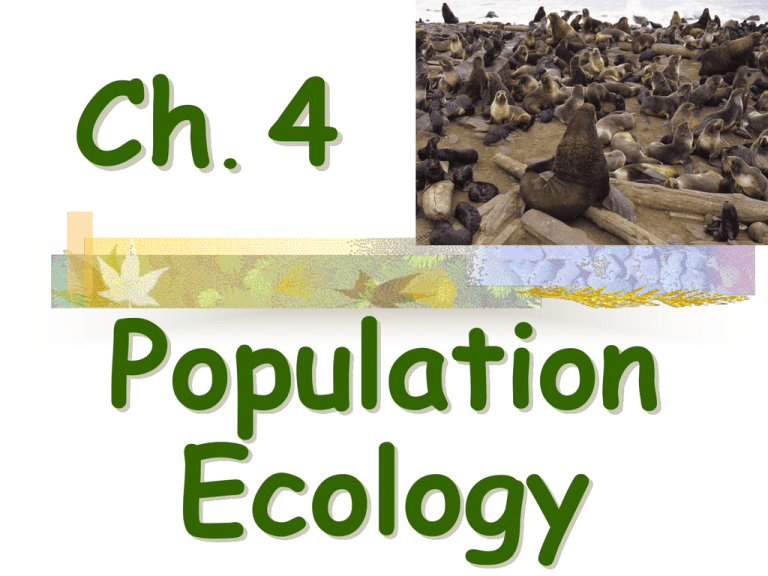Ch 4 Population Ecology
advertisement

Ch. 4 Population Ecology I. Population Dynamics - Biological processes constantly influence a population’s density, dispersion, and growth rate. Tent Caterpillars A. Population Characteristics 1.Population Density - number of organisms per unit area 2. Spatial Distribution - uniform, clumped, random Clumped Uniform Random 3. Population Range - depends on the species’ adaptations to biotic and abiotic factors Range of the Cougar Range of the Olympic Marmot B. Population-Limiting Factors 1. Density-Independent Factors - affect organisms regardless of population size Tsunami Forest Fire 2. Density-Dependent Factors - competition, predation, disease and parasites Snowshoe hare 160 120 Lynx 9 80 6 40 3 0 0 1850 1875 Year 1900 1925 Lynx population size (thousands) Hare population size (thousands) Snowshoe Hare and Lynx 2. Density-Dependent Factors Host-Parasite Relationship: Bean Weevil vs. Braconid Wasp C. Population Growth Rate - balance between biotic potential and environmental resistance Immigration Births Births and immigration add individuals to a population. Population Size Emigration Deaths Deaths and emigration remove individuals from a population. C. Population Growth Rate - balance between biotic potential and environmental resistance - Natality: birth rate - Recruitment: joining the breeding population - Mortality: death rate - Immigration - Emigration 1. Exponential Growth - shows an increasing growth rate (J-shaped curve) - results in population explosion 1. Exponential Growth Elephant Population 8,000 6,000 4,000 2,000 Exponential Growth in the African Elephant Population of Kruger National Park, South Africa 0 1900 1920 1940 Year 1960 1980 1. Exponential Growth 2. Logistic Growth 1,000 Number of Daphnia/50 ml Number of Paramecium/ml - population growth levels off at carrying capacity (S-shaped curve) 800 600 400 200 0 0 5 10 15 Time (days) Paramecium population 180 150 120 90 60 30 0 0 20 40 60 80 100 120 140 160 Time (days) Daphnia population 3.Boom-and-Bust Population Cycle - population greatly exceeds carrying capacity resulting in a population crash Annual lake algal bloom Conditions good: Boom Conditions bad: Bust Effects of Exceeding Carrying Capacity 1911 - 25 reindeer introduced 1938 - 2000 reindeer 1950 - 8 reindeer survived food (lichens) overgrazed St. Paul Island, Alaska D. Reproductive Patterns R-strategists K-Strategists 1. R-Strategists - adapted to unstable environments - short life spans - produce many offspring Locust Swarm Chum Salmon 1. R-Strategists - adapted to unstable environments - short life spans - produce many offspring Dandelion Chum Salmon 2. K-Strategists - adapted to more stable environments - long life spans - produce fewer offspring II. Human Population Growth - Humans are undergoing a population explosion. 6 4 3 2 The Plague 1 8000 B.C. 4000 B.C. 3000 B.C. 2000 B.C. 1000 B.C. 0 1000 A.D. 0 2000 A.D. Human population (billions) 5 Human Population Growth A. Technological advances have increased carrying capacity for humans - agricultural improvements - advances in sanitation and medicine - decrease in childhood mortality B. Demographic Transition - shift from high birth and death rates to low birth and death rate C. Rate of increase has slowed Demographic Transition in Sweden and Mexico, 1750–2050 (Data as of 2003) Birth or death rate per 1,000 people 50 40 30 20 10 Sweden Birth rate Death rate 0 1750 1800 Mexico Birth rate Death rate 1850 1900 Year 1950 2000 2050 Human Population Growth Rate by Country Age Structure Pyramids for the Human Population of Three Countries (2003) Rapid growth Afghanistan Male Female 8 6 4 2 0 2 4 6 8 Percent of population Age 85 80–84 75–79 70–74 65–69 60–64 55–59 50–54 45–49 40–44 35–39 30–34 25–29 20–24 15–19 10–14 5–9 0–4 Slow growth United States Female Male 8 6 4 2 0 2 4 6 8 Percent of population Age 85 80–84 75–79 70–74 65–69 60–64 55–59 50–54 45–49 40–44 35–39 30–34 25–29 20–24 15–19 10–14 5–9 0–4 Decreas e Italy Female Male 8 6 4 2 0 2 4 6 8 Percent of population Age Structure Diagram for Japan in 1950, 2005, and 2050 1950 2005 2050 Infant Mortality and Life Expectancy at Birth in Developed and Developing Countries 80 50 Life expectancy (years) Infant mortality (deaths per 1,000 births) 60 40 30 20 60 40 20 10 0 Developed countries Developing countries 0 Developed countries Developing countries Ecological Footprint in Relation to Available Ecological Capacity Ecological footprint (ha per person) 16 14 12 New Zealand 10 8 Australia Canada Netherlands Norway Japan 6 Sweden UK 4 Spain 2 0 USA Germany World China India 0 2 4 6 8 10 Available ecological capacity (ha per person) 12 14 16 The End







